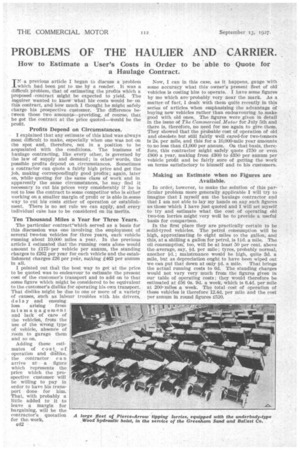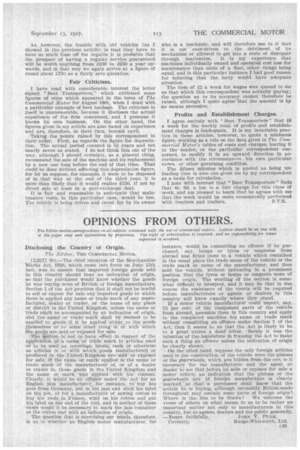PROBLEMS OF THE HAULIER AND CARRIER.
Page 64

Page 65

If you've noticed an error in this article please click here to report it so we can fix it.
How to Estimate a User's Costs in Order to be able to Quote for a Haulage Contract.
Iy.a previous article I began to discuss a problem which had been put to me lay a reader: It was a difficult problem, that of estimating the profits which a proPosed ,contract might be expected to yield. The inquirer wanted to know 'what his costs would be on this contract, and hew much I thought he might safely charge his prospective customer. The difference between those two amounts—providing, of course, that he got the contract at the price quoted—would be the profit.
Profits Depend on Circumstances.
I explained that any estimate of this kind was always most difficult to make, especially when one was not on the spot and, therefore, not in a position to be acquainted with the conditions. The business of haulage contracting, like every other, is governed by the law of supply and demand ; in other' words, the possible profits depend on circumstances. .Sometimes a contractor can quote a fairly high price and get the job, making correspondingly good profits; again, later on, while quoting for the same class of work and in apparently the same circumstances, he may find it necessary to cut his prices very censiderably if he is not to lose the contract to some competitor who is either working on a smaller margin of profit or is able in some way to cut his costs either of operation or establishment. There is no set rule we can apply, and every individual case has to be considered on its merits.
Ten Thousand Miles a Year for Three Years.
The particular contract"Which served as a basis for this discussion was one involving the employment of several two-ton vehicles for three years, each vehicle running about 10,000 miles a year. In the Previous article I estimated that costs alone would amount to £1751 per vehicle per annum, the standing charges to £262 per year for each vehicle and the establishment charges 1.26 per year, making £463 per annum in all.
I pointed out that the best way to get at the price to be quoted was to endeavour to estimate the present cost of the customer's transport and to add on to that some figure which might be considered to be equivalent to the customer's dislike for operating his own transport. That dislike might be due to one or more of a variety of causes, such as labour trotibles with his drivers, dela y and ensuing loss arising from in and lack of care of the velficIeS, from the use of the Wrong type of vehicle, absence of room to garage them
and so on. • Adding these estimates of cost of operation and dislike, the contractor, can arrive at a figure which represents the price which the prospective customer will be willing to pay in order to have his transport done for him. That, with probably a little added to it to leave a margin for bargaining, will be the
contractor's quotation A large fleet of Pierce-Arrow tipping rorries,equipped with the underbody-type for the. work.
042
Now, I can in this case, as it happens, gauge with some accuracy what this owner's present fleet of old vehicles is costing him to operate. I have some figures by me which are'probably very near the mark. As a matter of fact, I dealt with them quite recently in this series of articles when emphasizing the advantage of buying new vehicles rather than endeavouring tamake good with old ones. The figures were given in detail in the issue of The Commercial Motor for July 5th and there is, therefore, no need for me again to give them. They showed that the probable cost of operation of old and obsolete but still fairly well cared-for two-tonners is 2s. per mile, and this for a 10,000-mile year amounts to no less than /1,000 per annum. On that basis, therefore, this contractor might safely quote /750 or even £800 a year, making from £300 to /350 per annum per vehicle, profit and be fairly sure of getting the work on terms satisfactory to himself and to his customers.
Making an Estimate when no Figures are Available.
In order, however, to make the solution of this particular problem more generally applicable I will try to imagine that I myself am the haulage contractor and that I am not able to lay my hands on any such figures as those which I have just quoted and I will set myself to try and estimate what the cost of operating old two-ton lorries might very well be to provide a useful basis for comparison.
In the first place they are practically certain to be solid-tyred vehicles. The petrol consumption will be high, approximating to eight miles to the gallon, and this, at a shilling a gallon for petrol, is 1id. a mile. The oil, consumption: too, will be at least 50 per cent, above the-average, say, ,)-d. per mile; tyres, probably normal, another 4d.; maintenance would be high, quite 3d, a mile, but as depreciation ought to have been wiped out we can put that down at only id. a mile. That brings the actual running costs to fid. The standing charges would not vary very much from the figures given in our" table of operating costs; they would therefore be estimated at 150 Os. 90. a week, which is 6.40. per mile at 200, miles a week. The total cost of operation of these vehicles is therefore'12.4d. per mile and the. cost per annum in round figures £520.
As, however, the trouble with old vehicles (as I showed in the previous article) is that they have to have so much time off for repairs it is probable that the prospect of having a regular service guaranteed will be worth anything from £200 to £250 a year upwards, and in that way we again arrive at a figure of round about £750 as a fairly safe quotation.
Fair Criticism.
I have read with considerable interest the letter signed "Beet Transporters," which criticised some figures of mine which appeared in the issue of The Commercial Motor for August 16th, when I dealt with a particular example of beet haulage. The criticism in itself is unanswerable, because it discloses the actual experience of the firm concerned, and I presume it knows its own business. On the other hand, the figures given in my article are also based on experience and are, therefore, in their turn, beyond cavil.
Taking the points raised by this correspondent in their order. First, as regards the figure for depreciation. The actual period covered is 51 years and not nearly seven as stated. -I do not think this out of the way, although I should certainly, as a Oneral thing, recommend the sale of the machine and its replacement bya new one long before the end of that time. That could be done without affecting this depreciation figure, for let us suppose, for example, it were to be disposed of in that way at the end of the third year, it is mere than likely that-it would realize £150, if not by direct sale at least in a part-exchange deal.
It is fair and reasonable to anticipate that maintenance costs, in this particular ease, would be law. The vehicle is being driven and cared for by its owner who is a mechanic, and will therefore see to it that it is not over-driven to the detriment of its mechanism or allowed to get into a state of disrepair through inattention. It is my experience that machines individually owned and operated cost less for maintenance than units of a fleet, other things being equal, and in this particular instance I had good reason for believing that the lorry would have adequate attention.
The item of £2 a week for wages was quoted to me as that which this correspondent was actually paying; the question as to its accuracy cannot therefore be raised, although I quite agree that the amount IS by no means excessive.
Profits and Establishment Charges.
I agree entirely with "Beet Transporters" that 16 a week for the weekly total of profits and establishment charges is inadequate. It is my invariable practice in these articles, however, to quote a minimum figure, working as a rule on the data given in The Commercial Motor's tables of costs and charges, leaving it to the reader, or the particular correspondent concerned, to modify it in an upward direction in accordance with the circumstances, his own particular views, or other governing condition.
The fifteen minutes which is quoted as being unloading time is also one given me by my correspondent as a basis for calculation.
I note with interest that "Beet Transporters finds that 4s. Gd. a ton is a fair charge for this class of work, and am pleased to learn that he agrees with me that the work would be more economically performed with tractors and trailers. S.T.R.












































































































